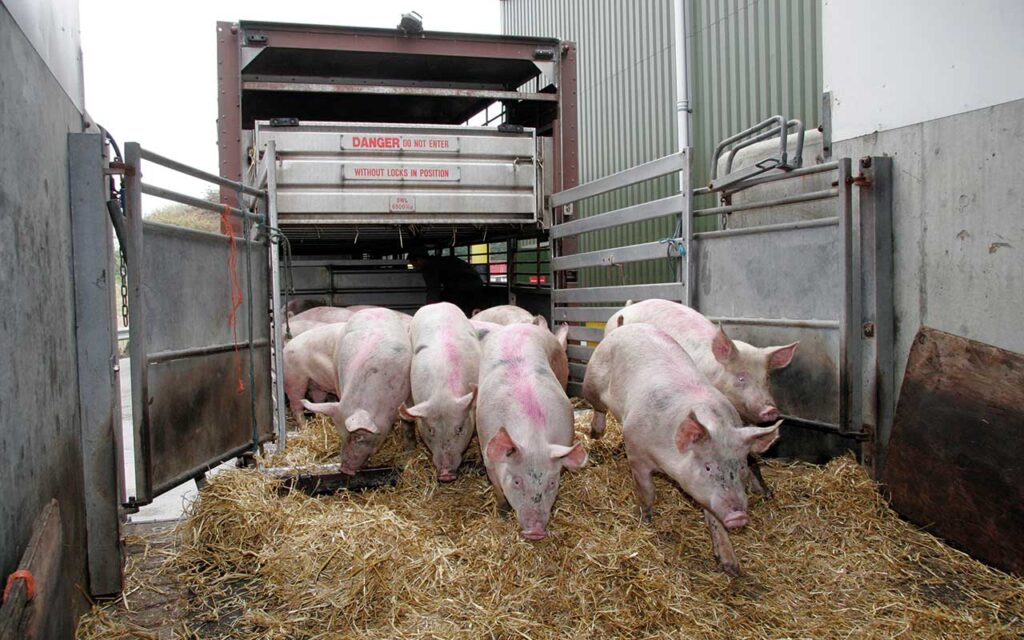Defra’s animal welfare advisors have recommended that CO2 is phased out as a method for stunning pigs pre-slaughter and for limits to be placed on throughputs at abattoirs to improve welfare.
The independent Animal Welfare Committee’s opinion on the ‘welfare impacts on pigs of high concentration CO2 gas stunning and of potential alternative stunning methods’, published today, calls for a transition to alternative methods within five years.
90% of pigs reared in England and Wales are stunned by being exposed to high concentration CO2 using paternoster CAS systems, according to a 2024 Food Standards Agency Slaughter Sector Survey. The remaining 10% of pigs are stunned using manual head only or head to body electrical stunning or for a very small number, percussive stunning with a penetrative captive bolt device.
The Farm Animal Welfare Council (FAWC), in 2003, and the European Food Safety Authority (EFSA), in 2004 and 2020, have previously recommended that stunning live pigs with direct exposure to high concentration CO2 gas mixtures should be phased out because exposure of conscious pigs to high concentrations of CO2 is ;known to be aversive to pigs’.
The report states that exposure of conscious pigs to high concentrations of CO2 is associated with three major welfare concerns: pain, respiratory distress and fear.
“These manifest behaviourally as vocalisations, hyperventilation and escape attempts. These are observed before loss of posture and hence occur in the conscious phase of the stunning process,” it says.
The reports looks into the viability of other methods of stunning, including exposure to an inert gas mixture such as Argon or Nitrogen. It notes that there are ‘technical challenges’ to using inert gases in current CO2 systems or with modification.
But it says immersion in argon ‘causes minimal immediate visible reaction, since these gases cannot be sensed directly by the pig’. “However, the induction of unconsciousness remains gradual, and it should be noted that all lethal CAS mixtures are associated with some degree of welfare compromise,” the report says.
It adds that there is no welfare benefit of adding CO2 to inert gases. The report also covers electrical stunning, captive bolt devices, pre-stun handling and considers issues around meat quality and costs and discusses the ethics of the different methods.
Recommendations
It makes a number of recommendations to government and industry, including:
- The use of CO2, including in combination with inert gases, as a method of stunning for pigs should be prohibited to prevent pigs experiencing avoidable pain, distress or suffering at slaughter associated with high concentration.
- Any transition period given to industry to enable the change to alternative methods of slaughter should be as short as possible and in any case within five years. Industry should seek to implement the changes as quickly as possible.
- Slaughter lines should be approved to slaughter no more than a specified number of animals per hour, such that each animal has time to move through the system without the need for physical coercion.
- Legislation should be amended to require pigs to be kept in a small social group, preferably with animals from their rearing group, during lairaging and slaughter.
- Government and industry should encourage research into technologies, such as automated video monitoring systems, to assess animal welfare and to detect harms in animal handling, stunning and slaughter processes in the abattoir.
NPA reaction
The NPA said the industry was committed to finding alternatives, but stressed that they must commercially viable and avoid unintended consequences.
NPA chief executive Lizzie Wilson said: “The NPA acknowledges concerns that the slaughter of pigs could and should be more humane, and we are part of a UK pig sector group which is committed to exploring alternatives and finding a solution that can deliver on animal welfare at the time of stunning and slaughter.
“Any new approach must be commercially viable, to ensure uptake, to ensure quality of meat, and to prevent any unintended consequences for welfare – for example, throughput capacity must be sufficient to ensure that pigs are not held on farm or in lairage for longer than necessary.
“We have awaited the outcomes of the AWC report with interest, and while it has delivered a comprehensive investigation into the welfare aspect of this issue, unfortunately there is still no conclusive ‘best’ alternative due to issues with throughput capacity, meat quality and cost.
“The UK pig industry must now work together to decide how we go forward.”




